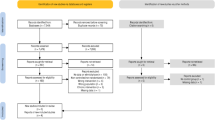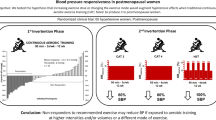Abstract
This study aimed to analyze the acute effects of combined calisthenic and walking exercises using different volumes on blood pressure (BP) in aging adults with primary hypertension. A total of 48 participants with primary hypertension aged 50–80 years were randomly assigned into two groups that performed two experimental sessions each: a non-exercising CONTROL session and a LOW (group 1) or HIGH (group 2) volume exercise session. The order of these sessions was randomized. The exercise protocols lasted 30 min (LOW) or 60 min (HIGH) and consisted of calisthenic exercises combined with continuous walking or jogging. Exercise intensity was controlled using a rating of perceived exertion (RPE) scale. BP was measured at baseline and after each session for 60 min. Results showed that systolic BP was lower after the HIGH session at post 30’ (p = 0.03), post 40’ (p = 0.03), post 50’ (p = 0.04), and post 60’ (p < 0.02), and after the LOW session at post 30’ (p = 0.02), post 40’ (p < 0.01), post 50’ (p < 0.01), and post 60’ (p < 0.01) when compared to the corresponding CONTROL at the same time point. There were no significant differences in systolic and diastolic BP between the HIGH and LOW sessions. In conclusion, a pragmatic combined training session using different volumes acutely reduces BP in older adults with primary hypertension.
This is a preview of subscription content, access via your institution
Access options
Subscribe to this journal
Receive 12 digital issues and online access to articles
118,99 € per year
only 9,92 € per issue
Buy this article
- Purchase on SpringerLink
- Instant access to full article PDF
Prices may be subject to local taxes which are calculated during checkout



Similar content being viewed by others
Data availability
The datasets generated during and/or analysed during the current study are available from the corresponding author on reasonable request.
References
Rapsomaniki E, Timmis A, George J, Pujades-Rodriguez M, Shah AD, Denaxas S, et al. Blood pressure and incidence of twelve cardiovascular diseases: lifetime risks, healthy life-years lost, and age-specific associations in 1·25 million people. Lancet. 2014;383:1899–911.
Oliveros E, Patel H, Kyung S, Fugar S, Goldberg A, Madan N, et al. Hypertension in older adults: assessment, management, and challenges. Clin Cardiol. 2020;43:99–107.
Gibbs BB, Hivert M-F, Jerome GJ, Kraus WE, Rosenkranz SK, Schorr EN, et al. Physical activity as a critical component of first-line treatment for elevated blood pressure or cholesterol: who, what, and how?: A scientific statement from the american heart association. Hypertension. 2021;78:e26–e37.
Saco-Ledo G, Valenzuela PL, Ramírez-Jiménez M, Morales JS, Castillo-García A, Blumenthal JA, et al. Acute aerobic exercise induces short-term reductions in ambulatory blood pressure in patients with hypertension: a systematic review and meta-analysis. Hypertension. 2021;78:1844–58.
Paluch AE, Boyer WR, Franklin BA, Laddu D, Lobelo F, Lee D-C, et al. Resistance exercise training in individuals with and without cardiovascular disease: 2023 update: a scientific statement from the american heart association. Circulation. 2024;149:e217–e231.
Mazzeo RS, Tanaka H. Exercise prescription for the elderly: current recommendations. Sports Med. 2001;31:809–18.
Carpes L, Jacobsen A, Domingues L, Jung N, Ferrari R. Recreational beach tennis reduces 24-h blood pressure in adults with hypertension: a randomized crossover trial. Eur J Appl Physiol. 2021;121:1327–36.
Ferrari R, Umpierre D, Vogel G, Vieira PJC, Santos LP, de Mello RB, et al. Effects of concurrent and aerobic exercises on postexercise hypotension in elderly hypertensive men. Exp Gerontol. 2017;98:1–7.
Dos Santos ES, Asano RY, Filho IG, Lopes NL, Panelli P, Nascimento Dda C, et al. Acute and chronic cardiovascular response to 16 weeks of combined eccentric or traditional resistance and aerobic training in elderly hypertensive women: a randomized controlled trial. J Strength Cond Res. 2014;28:3073–84.
Liu S, Goodman J, Nolan R, Lacombe S, Thomas SG. Blood pressure responses to acute and chronic exercise are related in prehypertension. Med Sci Sports Exerc. 2012;44:1644–52.
Carpio-Rivera E, Moncada-Jiménez J, Salazar-Rojas W, Solera-Herrera A. Acute effects of exercise on blood pressure: a meta-analytic investigation. Arq Bras Cardiol. 2016;106:422–33.
Brito Ade F, de Oliveira CV, Brasileiro-Santos Mdo S, Santos Ada C. Resistance exercise with different volumes: blood pressure response and forearm blood flow in the hypertensive elderly. Clin Interv Aging. 2014;9:2151–8.
de Freitas Brito A, Brasileiro-Santos MDS, Coutinho de Oliveira CV, da Cruz Santos A. Postexercise hypotension is volume-dependent in hypertensives: autonomic and forearm blood responses. J Strength Cond Res. 2019;33:234–41.
Guidry MA, Blanchard BE, Thompson PD, Maresh CM, Seip RL, Taylor AL, et al. The influence of short and long duration on the blood pressure response to an acute bout of dynamic exercise. Am Heart J. 2006;151:1322.e5–12.
Cohen-Mansfield J, Marx MS, Guralnik JM. Motivators and barriers to exercise in an older community-dwelling population. J Aging Phys Act. 2003;11:242–53.
Dulsky CC, Renzi CP, McLaurin NN, Wang T, Chen LS, Walters MR, et al. Effects of supra high-intensity interval training in police officers. J Sports Med Phys Fitness. 2023;63:543–9.
Ferrari R, Cadore EL, Périco B, Kothe GB. Acute effects of body-weight resistance exercises on blood pressure and glycemia in middle-aged adults with hypertension. Clin Exp Hypertens. 2021;43:63–8.
Marçal IR, Falqueiro PG, Fernandes B, Ngomane AY, Amaral VT, Guimarães GV, et al. Prescribing high-intensity interval exercise by rating of perceived exertion in young individuals. J Sports Med Phys Fitness. 2021;61:797–802.
Ferrari R, Domingues LB, Carpes LDO, Frank PDA, Schneider VM, Fuchs SC, et al. Effects of combined training performed two or four times per week on 24-h blood pressure, glycosylated hemoglobin and other health-related outcomes in aging individuals with hypertension: rationale and study protocol of a randomized clinical trial. PLOS ONE. 2021;16:e0251654.
Kerry D, Tianjing L, Douglas GA, Diana E. CONSORT 2010 statement: extension to randomised crossover trials. BMJ. 2019;366:l4378.
Tanaka H, Monahan KD, Seals DR. Age-predicted maximal heart rate revisited. JACC. 2001;37:153–6.
Howley ET, Bassett DR Jr, Welch HG. Criteria for maximal oxygen uptake: review and commentary. Med Sci Sports Exerc. 1995;27:1292–301.
Buckley JP, Borg GA. Borg’s scales in strength training; from theory to practice in young and older adults. Appl Physiol Nutr Metab. 2011;36:682–92.
Hanssen H, Boardman H, Deiseroth A, Moholdt T, Simonenko M, Kränkel N, et al. Personalized exercise prescription in the prevention and treatment of arterial hypertension: a Consensus Document from the European Association of Preventive Cardiology (EAPC) and the ESC Council on Hypertension. Eur J Prev Cardiol. 2022;29:205–15.
Haddad M, Stylianides G, Djaoui L, Dellal A, Chamari K. Session-RPE method for training load monitoring: validity, ecological usefulness, and influencing factors. Front Neurosci. 2017;11:612.
Cordeiro R, Monteiro W, Cunha F, Pescatello LS, Farinatti P. Influence of acute concurrent exercise performed in public fitness facilities on ambulatory blood pressure among older adults in Rio de Janeiro City. J Strength Cond Res. 2018;32:2962–70.
Cohen J. Statistical power analysis for the behavioral sciences, (Lawrence Erlbaum Associates: Hillsdale, 1988).
MacDonald JR, Rosenfeld JM, Tarnopolsky MA, Hogben CD, Ballantyne CS, MacDougall JD. Post exercise hypotension is not mediated by the serotonergic system in borderline hypertensive individuals. J Human Hypertens. 2002;16:33–9.
Marçal IR, Goessler KF, Buys R, Casonatto J, Ciolac EG, Cornelissen VA. Post-exercise hypotension following a single bout of high intensity interval exercise vs. a single bout of moderate intensity continuous exercise in adults with or without hypertension: a systematic review and meta-analysis of randomized clinical trials. Front Physiol. 2021;12:675289.
Jones H, George K, Edwards B, Atkinson G. Is the magnitude of acute post-exercise hypotension mediated by exercise intensity or total work done? Eur J Appl Physiol. 2007;102:33–40.
Graham MJ, Lucas SJE, Francois ME, Stavrianeas S, Parr EB, Thomas KN et al. Low-volume intense exercise elicits post-exercise hypotension and subsequent hypervolemia, irrespective of which limbs are exercised. Front. Physiol. 2016; 7:199.
Leal JM, Del Vecchio FB. Postexercise hypotension in men with parental history of hypertension: effects of mode and intensity. J Sports Med Phys Fitness. 2022;62:273–9.
Hertel G, Hochrein A, Suren C, Minzlaff P, Banke IJ, Willers J, et al. Injury incidence and specific injury patterns in app-based bodyweight training (Freeletics): results of an international survey with 3668 participants. BMC Sports Sci Med Rehabil. 2022;14:145.
Mao Y-R, Lo WL, Lin Q, Li L, Xiao X, Raghavan P, et al. The effect of body weight support treadmill training on gait recovery, proximal lower limb motor pattern, and balance in patients with subacute stroke. BioMed Res Int. 2015;2015:175719.
Hawley-Hague H, Horne M, Campbell M, Demack S, Skelton DA, Todd C. Multiple levels of influence on older adults’ attendance and adherence to community exercise classes. The Gerontologist. 2014;54:599–610.
Hawley-Hague H, Horne M, Skelton DA, Todd C. Review of how we should define (and measure) adherence in studies examining older adults’ participation in exercise classes. BMJ Open. 2016;6:e011560.
Acknowledgements
Vinícius M. Schneider and Rodrigo Abreu received a scholarship from Coordenação de Aperfeiçoamento de Pessoal de Nível Superior (CAPES) - finance code 001. The funders did not have a role in the study design, data collection, analysis, interpretation of results, or the manuscript.
Author information
Authors and Affiliations
Contributions
Vinicius M. Schneider; data collection, analysis and interpretation of results, drafted manuscript preparation. Rodrigo Abreu; data collection Hirofumi Tanaka; drafted the manuscript preparation. Rodrigo Ferrari; study conception and design, drafted the manuscript preparation. All authors edited and revised the manuscript and approved the final version of the manuscript.
Corresponding author
Ethics declarations
Competing interests
The authors declare no competing interests.
Additional information
Publisher’s note Springer Nature remains neutral with regard to jurisdictional claims in published maps and institutional affiliations.
Rights and permissions
Springer Nature or its licensor (e.g. a society or other partner) holds exclusive rights to this article under a publishing agreement with the author(s) or other rightsholder(s); author self-archiving of the accepted manuscript version of this article is solely governed by the terms of such publishing agreement and applicable law.
About this article
Cite this article
Schneider, V.M., de Abreu, R.F., Tanaka, H. et al. Post-exercise hypotension after different volumes of combined calisthenic and walking exercises in older adults with hypertension: a randomized controlled trial. J Hum Hypertens 39, 22–28 (2025). https://doi.org/10.1038/s41371-024-00972-9
Received:
Revised:
Accepted:
Published:
Issue Date:
DOI: https://doi.org/10.1038/s41371-024-00972-9



